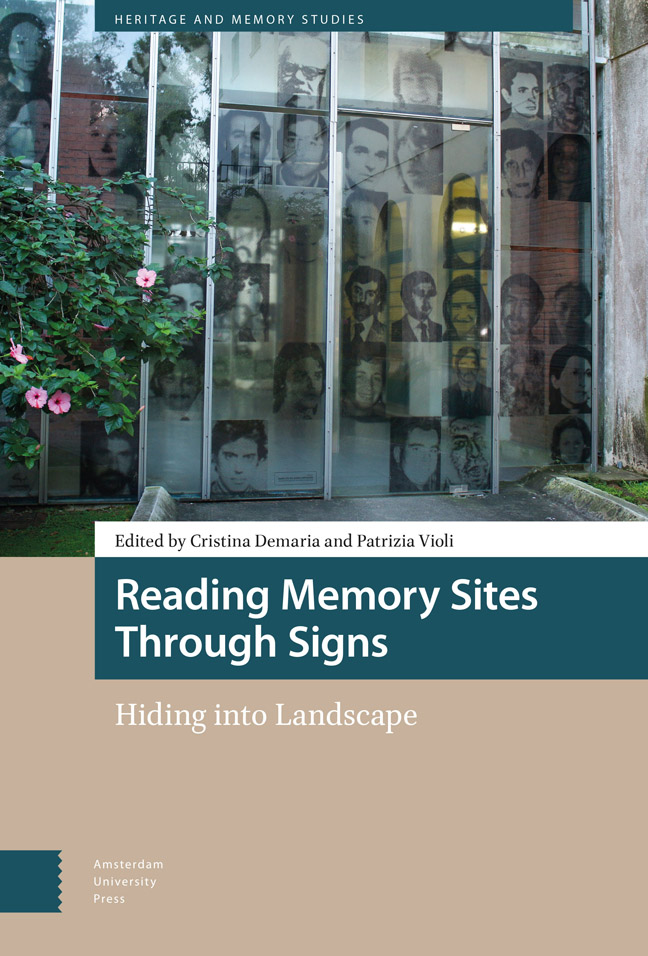Book contents
- Frontmatter
- Contents
- List of Illustrations
- For a Semiotics of Spaces of Memories: Practices of Enunciation and Narratives from Monuments to Global Landscapes of Inheritance
- 1 Stories that Shape Spatialities: Lieu and Milieu de Mémoire through the Lens of Narrativity
- 2 Interpretation and Use of Memory: How Practices Can Change the Meanings of Monuments
- 3 Uncomfortable Memories of Fascist Italy: The Case of Bigio of Brescia
- 4 What Does Fascist Architecture Still Have to Tell Us?: Preservation of Contested Heritage as a Strategy of Re-Enunciation and ‘Voice Remodulation’
- 5 Berlin, the Jewish Museum and the Holocaust Memorial
- 6 Making Space for Memory: Collective Enunciation in the Provincial Memory Archive of Córdoba, Argentina
- 7 Ruins of War: The Green Sea and the Mysterious Island
- 8 Turning Spaces of Memory into Memoryscapes: Cinema as Counter-Monument in Jonathan Perel's El Predio and Tabula Rasa
- 9 Voices from the Past: Memories in a Digital Space: The Case of AppRecuerdos in Santiago, Chile
- 10 500,000 Dirhams in Scandinavia, from Mobile Silver to Land Rent: A Semiotic Analysis
- Index
- Index of Names
8 - Turning Spaces of Memory into Memoryscapes: Cinema as Counter-Monument in Jonathan Perel's El Predio and Tabula Rasa
- Frontmatter
- Contents
- List of Illustrations
- For a Semiotics of Spaces of Memories: Practices of Enunciation and Narratives from Monuments to Global Landscapes of Inheritance
- 1 Stories that Shape Spatialities: Lieu and Milieu de Mémoire through the Lens of Narrativity
- 2 Interpretation and Use of Memory: How Practices Can Change the Meanings of Monuments
- 3 Uncomfortable Memories of Fascist Italy: The Case of Bigio of Brescia
- 4 What Does Fascist Architecture Still Have to Tell Us?: Preservation of Contested Heritage as a Strategy of Re-Enunciation and ‘Voice Remodulation’
- 5 Berlin, the Jewish Museum and the Holocaust Memorial
- 6 Making Space for Memory: Collective Enunciation in the Provincial Memory Archive of Córdoba, Argentina
- 7 Ruins of War: The Green Sea and the Mysterious Island
- 8 Turning Spaces of Memory into Memoryscapes: Cinema as Counter-Monument in Jonathan Perel's El Predio and Tabula Rasa
- 9 Voices from the Past: Memories in a Digital Space: The Case of AppRecuerdos in Santiago, Chile
- 10 500,000 Dirhams in Scandinavia, from Mobile Silver to Land Rent: A Semiotic Analysis
- Index
- Index of Names
Summary
Abstract
How might cinema turn a space into a mediated landscape of memory? How can it interrogate what is remembered in a lieu de memoire? Could the role of cinema be that of a monument or, even, a counter-monument? I address these questions through the semiotic analysis of the ways in which ESMA – Space for Memory and for the Promotion and Defence of Human Rights in Buenos Aires has been framed by two documentaries by Jonathan Perel: El Predio (2010) and Tabula Rasa (2013). Both films deal with the large, stratified trauma site of the former ESMA compound – the Escuela Superior de Mecánica de la Armada the most notorious clandestine centre of detention, torture and extermination that was operational in Argentina during the military regime.
Keywords: Documentary Cinema; ESMA – Space for Memory and for the Promotion and Defence of Human Rights; Jonathan Perel; Counter- Monument; Desaparecidos.
Landscape is a complex bearer of the possibilities of a plastic interpretation of emotion.
Sergei EisensteinHow might cinema turn a space into a mediated landscape of memory? How can it interrogate what is remembered there, and intervene in the porous borders that, simultaneously, separate and connect an event, its experience and its representation – that is, the multiple temporalities defining the very act of media witnessing? Could the role of cinema be that of a monument or even a counter-monument?
These questions guide my analysis of the ways in which ESMA-Space for Memory and for the Promotion and Defence of Human Rights, a memory site located in Buenos Aires, has been framed by two documentary films directed by Jonathan Perel: El Predio (“predio” means the “site”, the “place”, 2010) and Tabula Rasa (2013). Both films deal with the large, stratified and troubled trauma site of the former ESMA compound – the Escuela Superior de Mecánica de la Armada (Naval Academy of Mechanics) – arguably the most notorious of the clandestine centres of detention, torture and extermination that operated in the capital during the military regime's ‘Dirty War’ (1976–1983) (on this, see Sozzi supra). In this place, over 5,000 prisoners were detained, 90 per cent of whom were murdered. The ESMA compound was also the departure point of the aeroplanes from which drugged prisoners were thrown – still alive – into the River Plate.
Information
- Type
- Chapter
- Information
- Reading Memory Sites through SignsHiding into Landscape, pp. 207 - 230Publisher: Amsterdam University PressPrint publication year: 2023
